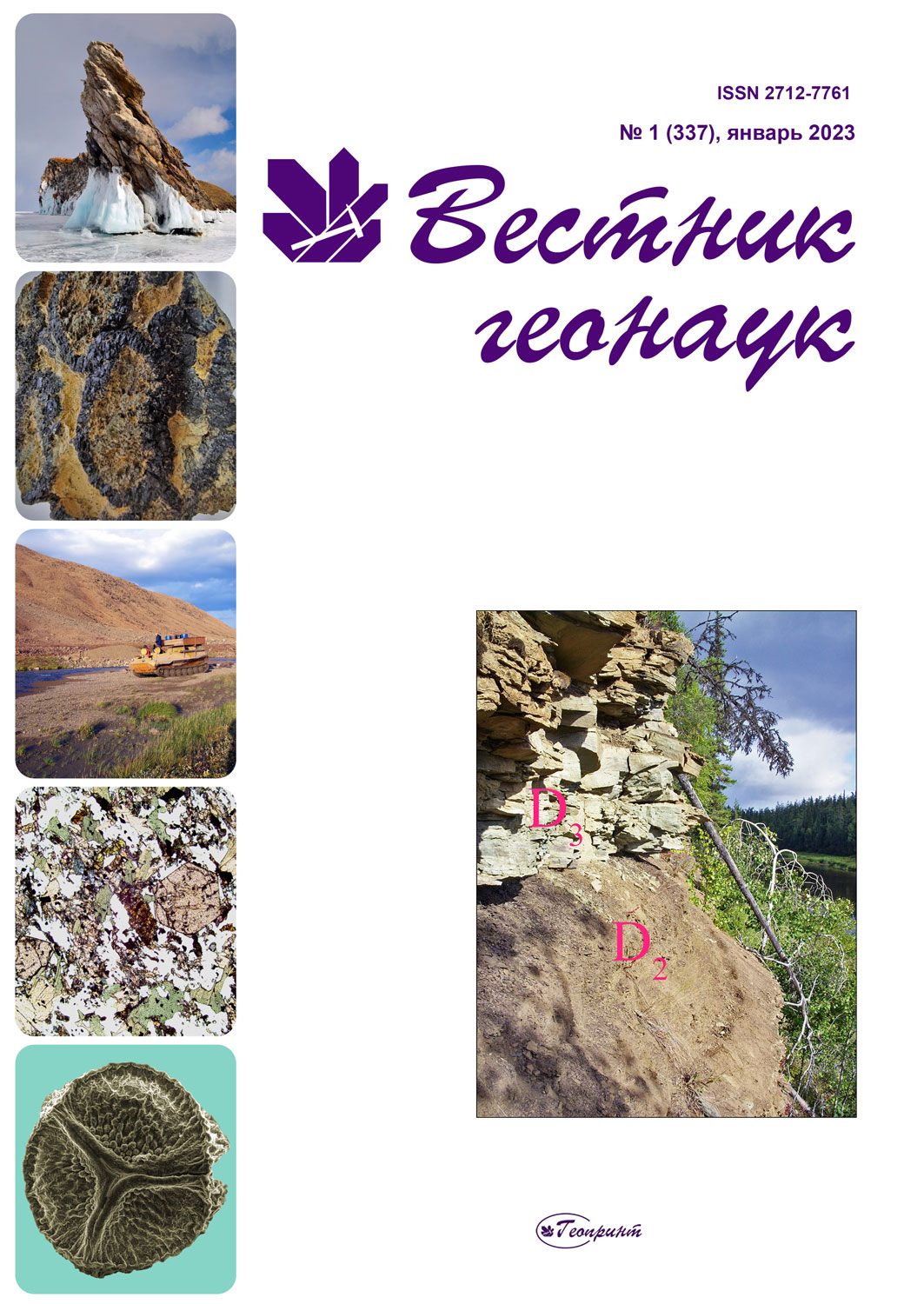pdf № 337, January
228 downloads

|
1 |
|
|
2 |
|
|
Entering 2023: consolidate on achieved gains and move on A. M. Askhabov |
3 |
|
On the cover: Middle Timan, outcrop 49, the Ustyarega Formation footwall at a height of 29 m from the river level. |
|
|
Scientific articles |
|
About the problem of the Middle-Upper Devonian boundary in the East European Platform I. O. EvdokimovaDOI: 10.19110/geov.2023.1.1 A brief overview of the history of the identification of the Frasnian Stage (Upper Devonian) and the determination of its lower boundary in the stratotype region is presented. The characteristics of the Givetian-Frasnian boundary deposits in the East European platform and the stratigraphic significance of the regional event levels are considered. Debatable issues on the age definition of the boundary deposits are discussed; tasks for the further investigations are set. Keywords: Givetian and Frasnian stages, Middle and Upper Devonian, stratigraphy, East European Platform. |
4—15 |
Palynological zonation of the Givetian-Frasnian stratigraphic interval in the Timan-Northern Urals region O. P. Tel’nova, I. Kh. ShumilovDOI: 10.19110/geov.2023.1.2 The zonal scheme of the Givetian-Frasnian boundary interval in the Timan-Northern Urals region was detailed according to the higher plants spores. Palynological zones were correlated with faunal, including conodont — orthostratigraphic group in the Devonian. The correlation of the identified critical boundaries in the development of plant communities with the divisions’ borders of the International Stratigraphic Scale — series and stages, were established and options for the level of the border of the Middle and Upper Devonian in the regional stratigraphic scheme of the new generation were considered. Keywords: palynozones, Middle-Upper Devonian, Timan-Northern Urals region. |
16—22 |
Assemblages of vertebrates and zones from the Upper Givetian and Lower Frasnian of the East European Platform and Urals A. O. IvanovDOI: 10.19110/geov.2023.1.3 The ichthyoassemblages from the Upper Givetian and Lower Frasnian deposits of the East European Platform and Urals. The Ichthyofaunistic zones established for the Main Devonian Field are traced in various subregions of the platform. The detailed phoebodontid zones of the Middle Urals are correlated to the Standard conodont zones. Keywords: ichthyofauna, zones, Givetian — Frasnian, East European Platform, Urals. |
23—29 |
Mineralogical and petrochemical features of gabbro-dolerites of the Krivoluksky complex A. A. Samigullin, D. E. SavelievDOI: 10.19110/geov.2023.1.4 The manuscript presents novel detailed mineralogical, petrographic and petrochemical studies of Early Vendian gabbro-dolerites of the Belskaya and Irlinskaya dikes of the Krivoluksky complex in the southeastern part of the Bashkir anticlinorium. We determined that the rocks of the complex underwent low-temperature changes, as a result of which dark-colored rock-forming minerals (amphiboles and pyroxenes) were completely replaced by chlorite. The gabbro-dolerites possess an increased content of sulfates strontium and barium. The geological position and contents of P2O5 and TiO2 cast doubt on the confinement of dikes near the village of Kaga to the Krivoluksky complex. Keywords: Krivoluksky complex, barite, celestine, petrography, dolerites, dykes, magmatism. |
30—41 |
Features of accumulation and migration of technogenic radionuclides Cs-137 and Sr-90 in the tundra landscapes of the Russian Arctic (evidence from the Nes river basin, Kanin tundra) A. V. Puchkov, E. Yu. YakovlevDOI: 10.19110/geov.2023.1.5 This article presents the results of studies of the lateral and vertical distribution of technogenic radionuclides Cs-137 and Sr-90 in peat and soils of the tundra territory of the Nenets Autonomous Okrug on the example of the Nes River basin (Kanin tundra). There are high levels of pollution density of Cs-137 and Sr-90 in the territory of the studied basin in comparison with the literature data. Such anomalies are associated with the mosaic nature of the lateral distribution of radionuclides, due to the geomorphological features of the territory. The results of calculating the isotopic ratios of two radionuclides showed that the main source of pollution can be global atmospheric fallout. Keywords: Arctic, technogenic radioactivity, Cs-137, Sr-90, migration, geomorphology. |
42—51 |
| Chronicle, events, facts. History of Science | |
|
About Middle-Upper Devonian boundary |
52 |
|
The 55th anniversary of the A. A. Chernov Geological Museum |
55 |
- 8(8212)24-53-53
- institute@geo.komisc.ru
- Mon.-Fri. 8.00-17.00












